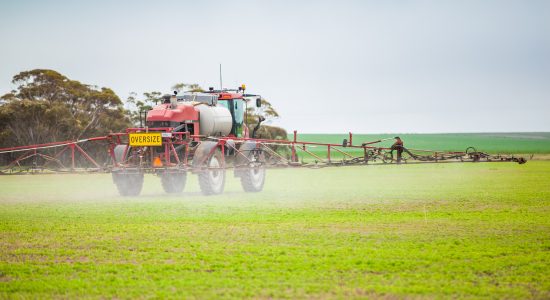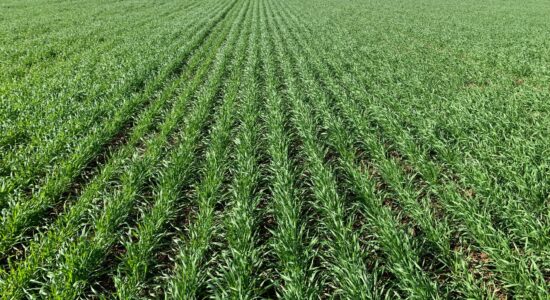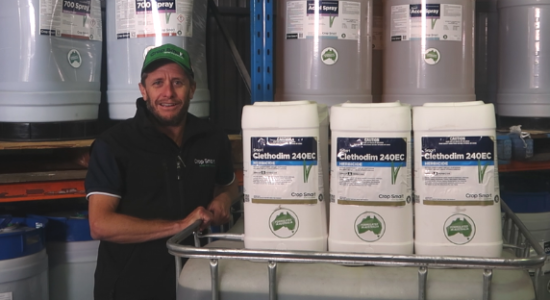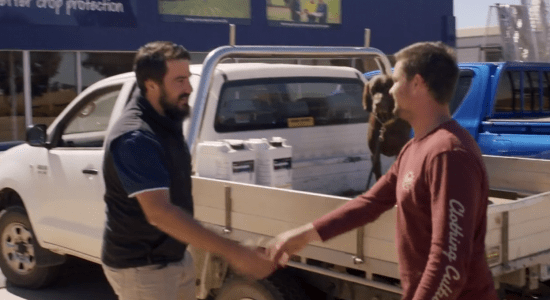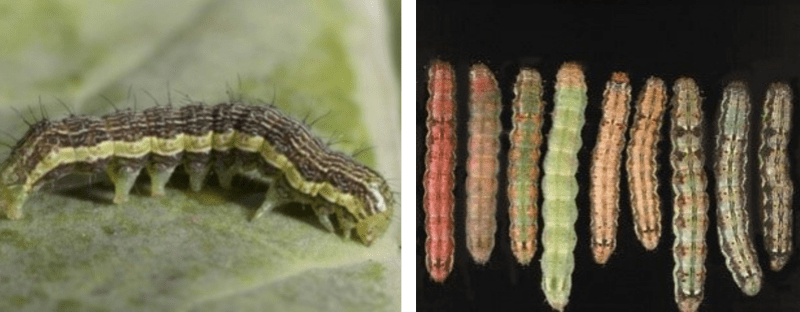
Pulse Alert : Economic Thresholds Reached Now For Controlling Pest Larvae in Crops
PULSE ALERT – ECONOMIC THRESHOLDS REACHED NOW FOR CONTROLLING PEST LARVAE IN CROPS
PULSE ALERT – ECONOMIC THRESHOLDS REACHED NOW FOR CONTROLLING PEST LARVAE IN CROPS
Native budworm (Helicoverpa punctigera) or Heliothis is a common & widespread pest in pulse & canola crops. Since native adult moths migrate into crops laying eggs, these larvae (caterpillars/grubs) hatch & infest foliage, pods & attack newly forming grain causing economic loss. Freshly hatched larvae are quite small (approximately 1.5 mm), light in colour with dark brown heads. They will grow through six or seven stages (or instars) until reaching maturity (up to 40 mm long). Once economical thresholds are reached, effective insecticide application is recommended, for best results application should commence once larvae are small (<7 mm/1st – 3rd instar).
Native budworm prefers broadleaf plants & attack pulse crops such as Vetch, Field Peas, Faba/Broad Beans, Lentils, Chickpeas, Lupins, as well as Canola, Lucerne, Sunflower, Safflower, Annual Medic and Clover species.
Heliothis are most damaging when they feed on the fruiting parts & seeds of our pulse crops. During the formation & development of pods, Vetch, Field Pea, Chickpea, Lentil & Faba/Broad Bean crops are very sensitive to Heliothis larvae attacks. Small grubs can enter emerging pods & damage the developing grain while larger larvae may consume the entire pod contents causing significant economic loss.
Generally narrow-leafed Lupin & Canola crops will have reduced damage by Heliothis feeding until they are close to maturity and leaf fall commences. In Canola the Diamondback Moth (Plutella xylostella) generally causes more economic damage once thresholds have been reached.
Holes or chewing damage may be seen on pods &/or seed heads. Larvae may be seen or remain embedded in the seed pod. Crop losses attributed to Heliothis come from direct weight loss through seeds being wholly or partially eaten which reduces overall crop yield. Grain quality may also be threatened through unacceptable levels of chewed or distorted/defective grain. Heliothis larvae eat increasing quantities of seed & plant material as they grow. The last two growth stages (5th & 6th instar) can account for over 90% of their total grain consumption, hence an early insecticide application is important for the economic control!
Currently in the Victorian Southern Mallee & Wimmera districts, economic thresholds have now been reached in the northern areas & will strengthen over the next several days. Small larvae are generally easier to control because they are more susceptible to insecticides & leaf feeding makes them susceptible to ingestion of active residues on the plant surface. Larvae entrenched in buds & pods (like hatched Lucerne Seed Web Moth or Etiella in Lentils for example ((Etiella behrii)) will be more difficult to control & chemical residual will be important in contacting them.
As a guide to reach economic thresholds, we need to consider the following three factors including:
- The value of the crop ($/mt)
- The cost of control (spraying & insecticide cost)
- The economic loss (yield &/or quality) based on larvae populations present.
Obviously, control is warranted if the cost of control is less than the value of the yield loss predicted. Considering current pulse crop commodity values are ranging anywhere from approximately $350.00-$380.00mt (Field Peas) to $900.00-$1,000.00mt (Lentils) & yields are currently promising in our region, residual insecticide costs between $2.30 – $3.90/Ha & $7.50/Ha spraying application (total max. cost is $11.40/Ha) only 1 – 3 Heliothis larvae population is required in pulse crops to reach the economic threshold to control!
For further information on economic thresholds please see:
https://www.agric.wa.gov.au/grains/management-and-economic-thresholds-native-budworm?page=0%2C4
CURRENT RECOMMENDATION:
We’ve been monitoring pulse crops in the Victorian Southern Mallee & Wimmera districts over the past 14 days since migratory adult moths’ flights have occurred. We suggest the following as a general guide, please contact your Crop Smart agronomist for a specific region to discuss & plan further:
- Southern Mallee & Northern Wimmera (Hopetoun, Yaapeet, Rainbow, Jeparit, Beulah, Brim, Birchip, etc.) – Insecticide application for Native Budworm to commence during the week between Monday 4th – Monday 11th October (which has already occurred & earlier in the more northern areas), this will also coincide with Lucerne Seed Web Moth or Etiella (Etiella behrii) predicted hatchings in Lentil crops considering the 351 degree-day accumulations have been met based on historical & predicted temperature ranges (e.g. Swan Hill, VIC – 29th September, Wagga Wagga, NSW – 9th October).
- West, Central & Eastern Wimmera (Nhill, Dimboola, Gerang Gerung, Glenlee, Antwerp, Kalkee, Warracknabeal, Donald, Minyip, Murtoa, Jung, etc.) – Commence during the week between Wednesday 13th – Wednesday 20th October, this will also coincide with Lucerne Seed Web Moth or Etiella (Etiella behrii) predicted hatchings in Lentil crops considering the 351 degree-day accumulations have been met based on historical & predicted temperature ranges (e.g. Horsham VIC has already occurred – 16th October, Bendigo, VIC – 20th October).
- Southern Wimmera (Horsham, Lower Norton, Laharum, Natimuk, Clear Lake, Noradjuha, Clear Lake, Toolondo, Telangatuk East, etc.) – Commence between Wednesday 20th – Wednesday 27th The further southern locations, generally the later the application due to the cooler climate & limited larvae hatchings. Continue to monitor these populations before commencing your spraying program as these dates will have the greatest variation based on the location, climatic conditions & crop growth stage.
When commencing the insecticide application, please start with the earlier sown pulse crops first (Vetch seed crops, Faba/Broad Beans, Lupins, Lentils, etc.) with the most mature or higher pod numbers & work through concluding your program on the later sown pulse crops (Field Peas, Chickpeas, etc.).
INSECTICIDE RATES:
All pulse crops including Vetch, Faba/Broad Beans, Lupins, Field Peas, Chickpeas, etc. except for Lentils (as Alpha-Cypermethrin isn’t registered):
Smart Ace/Alpha-Cypermethrin (100g/L Alpha-Cypermethrin) @ 300mL/Ha + Smart 700/Li 700 @ 0.2%
Water rate = 70-80L/Ha.
- Trojan (150g/L Gamma-Cyhalothrin) @ 30mL/Ha or Sumi-Alpha Flex (50g/L Esfenvalerate) @ 330mL/Ha is also registered on these pulse crops
Lentil crops only:
Trojan (150g/L Gamma-Cyhalothrin) @ 30mL/Ha or Sumi-Alpha Flex (50g/L Esfenvalerate) @ 330mL/Ha + Smart 700/Li 700 @ 0.2%
Water rate = 70-80L/Ha.
These insecticides have some residual properties at these rates (the higher the rate the increased residual control). As a guide they will control pest larvae for up to 14 days with a 5 – 7-day anti-feed period also which provides approximately 21 days crop protection. Monitoring of pulse crops should re-commence approximately 14 – 21 days post application for assessment on larvae populations if a secondary application is required.
If late protectant & systemic fungicide applications (e.g. Chlorothalonil, Carbendazim, Tebuconazole, Prothioconazole, Azoxystrobin, etc.) are required in crops like Chickpeas, Lentils, Faba/Broad Beans, Vetch, etc. these can be tank mixed with these insecticides also. With recent spring rainfall events, crop growth stage, yield potential, preservation of genetic variety resistance & the strengthening forecast, these fungicide applications are encouraged on higher valued pulse crops to provide pod/seed protection over the next 2 – 3-week period during the important grain filling stage.



